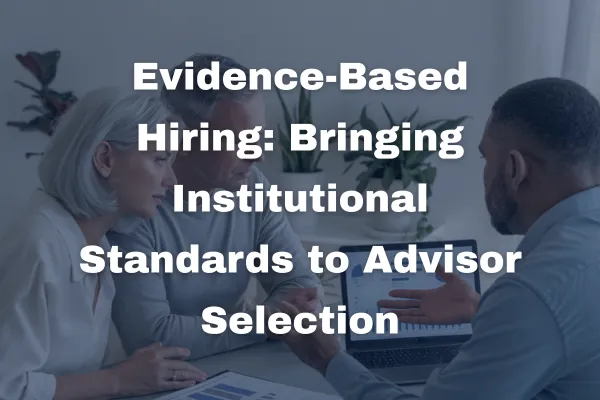
Evidence-Based Hiring: Bringing Institutional Standards to Advisor Selection
What do I do when they all look and sound alike?
(How investors can move from intuition to verification)
“Incentives quietly shape every outcome.” - Paul Powell
Most investors choose a financial advisor the same way they might choose a contractor or a doctor—by asking for referrals, browsing websites, and going with whoever “feels right.”
It’s an emotional decision made inside an industry that rewards confidence over competence.
Institutions take a different approach.
Before a large pension fund or endowment entrusts a dollar to an advisor, they run a disciplined selection process that’s measured, documented, and repeatable.
Evidence-Based Hiring™ applies that same discipline to personal finance—transforming advisor selection from a trust-based leap into a verifiable process of proof.

1. The Problem with Traditional Advisor Selection
Trust is essential in finance—but trust without evidence is risk disguised as comfort.
Individual investors are often persuaded by presentation, personality, or polished branding. Advisors are incentivized to look credible, not necessarily to be measurable.
The result?
A selection process driven by perception rather than performance.
And once hired, few advisors are ever re-evaluated.
Institutions learned decades ago that this approach creates unmeasured risk.
They replaced intuition with evidence.
2. How Institutions Hire Advisors
When institutions hire an advisor or asset manager, every claim must be proven.
They ask questions like:
What specific expertise supports your strategy?
How do you define and measure success?
How are your incentives structured relative to performance?
What oversight and audit processes are in place?
Each answer is documented, benchmarked, and reviewed annually.
The principle is simple: if it can’t be measured, it can’t be trusted.
3. Introducing the Evidence-Based Hiring™ Framework
4. The Psychological Shift: From Trust to Proof
For many investors, this shift is uncomfortable at first.
We’re conditioned to see advisors as experts to defer to, not professionals to verify.
But this mindset is precisely what keeps the industry opaque.
When trust becomes unconditional, accountability disappears.
Evidence-Based Hiring isn’t about skepticism—it’s about stewardship.
It doesn’t replace trust; it earns it.
5. How to Apply It
You don’t need a financial background to apply institutional standards.
You need a system.
Start by asking your advisor (or any candidate) these questions:
Can you show written documentation of performance vs. benchmark?
Who pays you, and for what specifically?
What certifications or designations do you hold, and are they current?
What steps do you take each quarter to review my plan and report results?
If those questions create hesitation or vague answers, that’s your evidence.
6. The Future of Advisor Accountability
As transparency becomes the new currency of trust, investors will increasingly demand proof of value—not promises.
Advisors who resist accountability will fade into irrelevance.
Those who embrace it will attract informed clients who expect measurable results.
Evidence-Based Hiring marks that inflection point.
It’s not a trend—it’s a return to first principles.
Conclusion:
Financial trust should be earned through evidence, not emotion.
By applying the same standards used by institutions, investors can bring clarity, confidence, and discipline to every advisory relationship.
Evidence-Based Hiring™ isn’t about questioning your advisor’s integrity.
It’s about verifying their impact—and protecting yours.
Next Step: Access the Full Framework
Download “Financial Self-Defense”
The complete 27-question checklist that helps you apply the Evidence-Based Hiring™ process with institutional rigor.